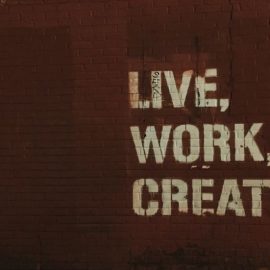

This article is an excerpt from the Shortform book guide to "Linchpin" by Seth Godin. Shortform has the world's best summaries and analyses of books you should be reading.
Like this article? Sign up for a free trial here.
What is Seth Godin’s linchpin theory? What are the defining characteristics of a linchpin employee?
In his book Linchpin, Seth Godin explains his linchpin theory as the steps you can take to start living your most fulfilling work life. According to him, anyone can choose to create work that changes the world by becoming a “linchpin.”
Read on to learn the three defining characteristics of a linchpin, according to Godin’s linchpin theory.
What Is the Linchpin Theory?
According to entrepreneur and author Seth Godin, linchpins are people who see the work they do as a gift to others, follow their own directions rather than anyone else’s, and commit to being their authentic selves. These characteristics make up the foundation of the linchpin theory, which is meant to teach you a new way of thinking that will empower you to live up to your full potential.
In Godin’s book Linchpin, he claims that you don’t have to quit your job or start your own business to be a linchpin—no matter what your life looks like, you can find fulfillment by applying the linchpin theory to your work. In this article, we’ll further explore these three key characteristics and and explain how they create the most indispensable employees in an organization, according to Godin.
(Shortform note: Godin uses the word “linchpin” because these workers’ organizations depend on them so much that they hold the operation together (like a physical linchpin holds together wheels and axles). Despite this name, however, you can still embody the linchpin theory working alone. The linchpin theory motivates you to do creative, fulfilling, high-quality work, which is valuable even without an organization to hold together.)
#1: Linchpins Rely on Self-Motivation
Godin explains that the defining characteristic of linchpins is that they see their work as a gift they give rather than an obligation or reciprocal transaction. If you’re an employee, your gift would be any effort you put into your work beyond the minimum requirements of your job description. This extra effort is a gift because you’re positively impacting someone’s life without assurance that you’ll get anything in return.
For example, a non-linchpin museum tour guide might dryly recite a memorized script because that’s all they’re getting paid to do. In contrast, a linchpin tour guide might ask questions to get to know the people on the tour, come up with jokes to weave into the tour, and learn fascinating historical facts that aren’t in the tour script to give museumgoers the gift of the best museum experience possible.
Godin asserts that when you see your work as a gift, you’ll find that giving that unconditional gift to others makes you happy, and you’ll work hard to exceed their expectations no matter what rewards you receive for it. In other words, you become internally motivated rather than externally motivated. Since the impact of your gift on others is what gives you satisfaction, you become emotionally invested in whether your work succeeds in affecting people. This intrinsic motivation makes you more likely to persist in the face of setbacks, learn from mistakes, and progress toward constructive goals.
| Be a Giver, Not a Pushover According to Godin’s linchpin theory, you should give your effortful work as a gift without expecting anything in return. However, be careful not to give too much by spending your time and energy indiscriminately. In Give and Take, Adam Grant categorizes all workers as either givers, takers, or matchers, depending on how they prioritize their desires versus the desires of others. Grant finds that givers who prioritize others’ desires over their own are the highest-performing and most successful, which aligns with Godin’s argument for linchpins. However, Grant finds that the worst-performing workers are also givers. The difference between givers who succeed and those who fail is that givers who fail neglect their own desires entirely. They let others dictate how they spend their time and energy, and consequently, they end up exhausted and ineffective. How do you avoid making this mistake? Remember that by advocating for your own desires, you’re also advocating for everyone you intend to serve. By saying no to some requests, you preserve time and energy to do valuable linchpin work of your choice—intrinsically motivating work that, as Godin explains, makes you happy, filling you with energy rather than draining you. |
Godin makes it clear that this focus on giving rather than getting doesn’t mean that you should tolerate it if your employer neglects to give you proper support. If your boss is limiting your ability to give your gifts by forcing you to obey strict, ineffective directions, Godin encourages you to quit and find an organization that appreciates good work. However, most of the time, you won’t have to quit: Many people assume that their bosses won’t let them implement ideas beyond their job description, but in reality, the majority of managers will appreciate your decision to start contributing wholeheartedly, even if it means breaking away from the way your organization normally does things.
(Shortform note: Godin argues that most bosses will appreciate more creative work. However, if your boss does want to restrain you, and you’re unable to quit your job, you may have to adopt strategies for managing such bosses and strive to be a linchpin anyway. In Extreme Ownership, Jocko Willink and Leif Babin argue that it’s your responsibility to convince your boss that your original ideas are valuable. Instead of blaming the people in charge for holding you back, work harder to clarify to them exactly how your ideas serve the organization’s mission. For this to work, you need to be as professional, respectful, and persuasive as you can be.)
#2: Linchpins Only Follow Their Own Directions
According to Godin’s linchpin theory, in addition to seeing their work as a gift, linchpins decide for themselves how best to give those gifts. Since they’re motivated by the positive impact they have on others, linchpins are constantly searching for new and better ways to make that impact at work, rather than merely following directions and meeting expectations. Similarly, linchpins work to resolve any problem they encounter if it threatens the gift they’re giving, even if solving that problem isn’t technically part of their job description. In short, linchpins don’t do the job they’re given; they do the job they give themselves.
Ideally, linchpins’ bosses give them the autonomy and authority to do things differently and experiment at work, trusting that they’ll find new ways to contribute value to the team. However, Godin notes that at times, linchpins following their own directions will upset the status quo in a way that invites criticism or even hostility from those in charge. Thus, being a linchpin requires you to risk disapproval.
| How Netflix Encourages Self-Directed Work Godin asserts that workers need to constantly invent and follow their own instructions to be valuable, innovative linchpins. But if employees are the ones directing their own work, what can managers do to ensure that their employees are successful? In No Rules Rules, Netflix co-founder Reid Hastings describes how the company nurtures this type of employee-led work. When a Netflix team member has an idea to improve the organization or solve a problem, their managers allow them to pursue that idea even if the manager thinks it would be a mistake. When evaluating employees, Netflix managers don’t penalize workers if some of their big ideas fail. Instead, they penalize employees for failing to take enough innovative risks. In other words, they force employees to face the fear that someone will disapprove of their ideas by explicitly disapproving of inaction even more. However, Hastings argues that such a setup will only work if you’ve exclusively hired talented people and have cultivated an environment of total transparency and frequent feedback. Netflix sets a policy to regularly fire average employees, so the company is only left with exceptional team members. If one of those exceptional team members is fighting for an idea, it’s likely to be a good one. Additionally, the company mandates its employees to offer honest feedback on everyone’s ideas. This way, employees who direct their own work receive all the information they need to make wise decisions. |
#3: Linchpins Are Committed to Authenticity
Godin argues that the kind of “linchpin” work we’ve been discussing—the work you give as a gift and decide for yourself how best to accomplish—comes naturally to human beings. We all want to help others in ways we decide for ourselves. Therefore, the last characteristic of the linchpin theory is authenticity: Linchpins communicate their honest thoughts and feelings at work, and by doing so, they create emotional connections with other people that add value to the organization (as we’ll discuss more later). Being authentic and connected to others at work is deeply satisfying, which is a large part of why linchpins live the most fulfilling lives.
In contrast, non-linchpins are inauthentic at work. Non-linchpins pretend to care about what they do, but in reality, they just want to follow directions, exert minimal effort, and collect a paycheck.
(Shortform note: Although experts agree with Godin that authenticity is valuable at work, they caution that it’s possible to be too authentic at work. Sharing too much about yourself too quickly can make you seem unprofessional or emotionally unstable, especially in more formal working environments. While it’s fulfilling to have friends at work, your co-workers may not be interested, and trying to force a connection can drive you apart. Instead, be strategically authentic—only reveal personal information that’s directly relevant to the work you’re doing, at least until you get a sense of your organization’s expected level of intimacy.)

———End of Preview———
Like what you just read? Read the rest of the world's best book summary and analysis of Seth Godin's "Linchpin" at Shortform.
Here's what you'll find in our full Linchpin summary:
- Why you must become a "linchpin" if you want to create work that changes the world
- The steps you can take to become a linchpin
- How bosses can nurture and manage linchpin employees






